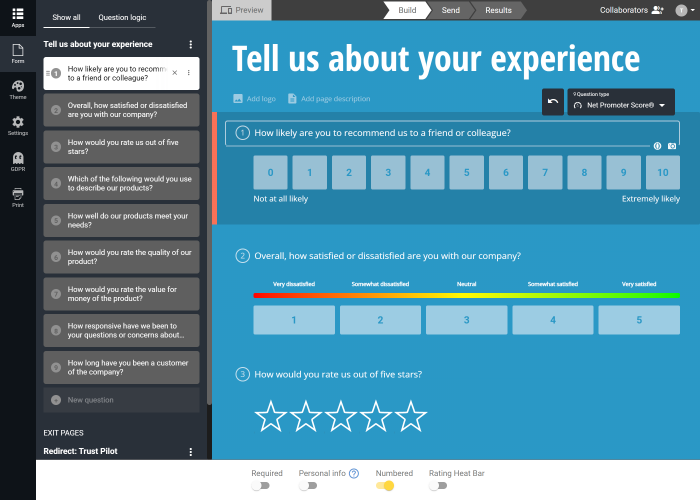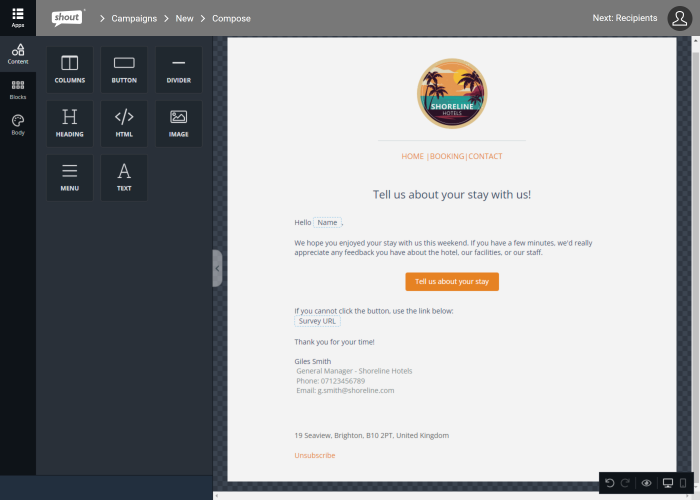Everything you need to improve satisfaction
Whether you’re a small business or an enterprise level organization, Shout has features to help you scale based on customer feedback.
25+ question types
From multiple-choice and scales, to numeric fields and open feedback, you’re spoilt for choice when it comes to question types.
Collect contact data
Capture contact information, record consent, and track the legal basis for processing their data with our integrated CRM.
Unique pathways
Use question logic to create bespoke pathways through your survey based what answers customers select.
Full brand control
Add logos, customize designs, use a custom domain and white label surveys to put your brand front-and-center.
A/B test content
Split test sections of text, images, and videos in your survey to determine what performs best with customers.
Identify pain-points
Segment and compare CSAT data in your report to identify what you’re doing well and what could be improved.
Do more than measure satisfaction

Collect customer feedback in a way that suits you
Send surveys directly to customer inboxes

Customers, Collaboration & Compliance
Collect feedback and strengthen customer relationships without worrying over whether you’re compliant.
Store and manage contacts, with compliance in mind
Assign contact groups a lawful basis for processing data to ensure you’re as compliant as possible.
Collaborate as a team, and grow your business together
Invite your colleagues to join your Shout team and collaborate on customer satisfaction surveys and reports in real time.
Pseudonymize data, whilst tracking who’s responded
Store personal information and response data separately to maximize compliance, whilst still being able to track responses.
Ready to improve customer satisfaction?
Create customer satisfaction surveys to collect feedback from the people who matter most to your business.
Customer Satisfaction FAQs
Everything you need to know about customer satisfaction surveys and how to improve customer relationships and increase revenue.
Customer satisfaction refers to the level of contentment and fulfilment that customers feel after interacting with a product, service, or brand. It’s a subjective measure that encompasses customers’ perceptions, experiences, and emotions related to their overall interaction with a business.
Customers feel satisfied when their expectations are met or exceeded, leading to a positive perception of the product or service. Various metrics are employed to gauge customer satisfaction, including Customer Satisfaction Score (CSAT), Net Promoter Score (NPS) survey, and Customer Effort Score (CES).
Customer Satisfaction Score (CSAT): CSAT is a metric that directly measures customers’ overall satisfaction with a product or service. It typically involves a survey with a scale or rating system, asking customers to express their satisfaction level.
Net Promoter Score (NPS) Survey: NPS is a metric that assesses the likelihood of customers recommending a product, service, or brand to others. It categorizes customers into promoters, passives, or detractors based on their responses, providing insights into the overall loyalty and satisfaction of the customer base.
Customer Effort Score (CES): CES measures the ease with which customers can accomplish tasks or resolve issues related to a product or service. A lower customer effort score indicates a smoother and more satisfying customer experience.
Customer feedback is crucial at various stages of the customer journey, offering invaluable insights that contribute to the enhancement of products and services.
It’s particularly important during interactions with the customer service team, as feedback obtained in real-time can identify areas of improvement and ensure immediate issue resolution.
Monitoring customer sentiment through feedback helps businesses gauge satisfaction levels, enabling them to address concerns promptly. Furthermore, the significance of customer feedback extends beyond short-term improvements; it plays a pivotal role in shaping long-term strategies.
By consistently gathering and analyzing customer feedback, businesses can adapt to evolving customer needs and preferences, fostering loyalty and sustained satisfaction throughout the entire customer journey.
Knowing when to ask for customer feedback is crucial to maximizing response rates and obtaining valuable insights. Time customer feedback requests strategically, and align them with key touchpoints in the customer journey.
For instance, after a successful purchase or when a service request has been resolved, customers are more likely to provide feedback.
Additionally, consider the timing in relation to the customer’s experience with your product or service to capture their sentiments while the experience is still fresh in their minds.
Avoid overwhelming customers with frequent surveys, as this may lead to survey fatigue and lower response rates.
By thoughtfully planning when to administer a customer feedback survey, businesses can strike a balance, ensuring high-quality responses and a comprehensive understanding of customer satisfaction and preferences.
When designing customer satisfaction surveys, it’s essential to use a combination of question types to gather comprehensive feedback. Here are sample questions with the specified keywords:
1. Rating Scales:
- On a scale of 1 to 5, how satisfied are you with the overall quality of our [product/service]?
- Please rate your level of agreement with the statement: “Our customer service met your expectations.”
2. Multiple-Choices:
- Which aspects of our [product/service] do you find most valuable? (Select all that apply)
A: Price
B: Features
C: Customer support
D: Ease of use
3. Open-Ended Questions:
- Can you share a specific experience where our [customer service/ product] exceeded your expectations?
- If there is one thing you would like us to improve or change, what would it be?
By incorporating a many different types of questions, you can gather both quantitative and qualitative insights into customer satisfaction.
Rating scales provide numeric data, multiple-choice questions allow for structured responses, and open-ended questions encourage customers to share detailed feedback and suggestions, enhancing the overall depth of your survey results.
